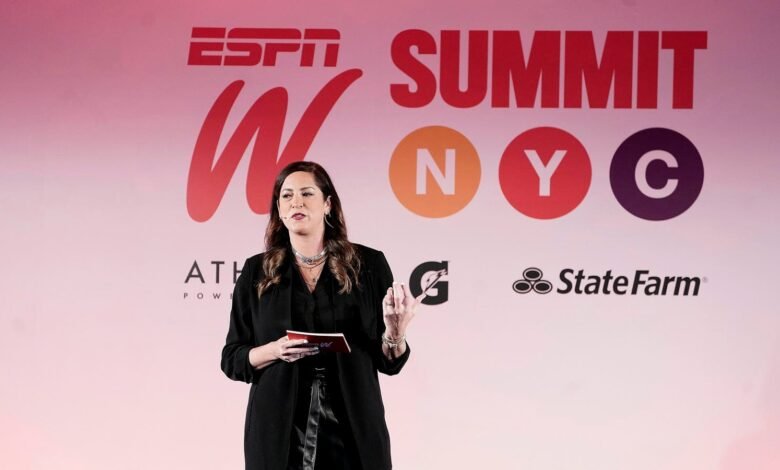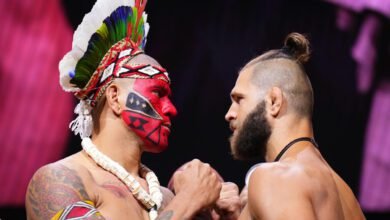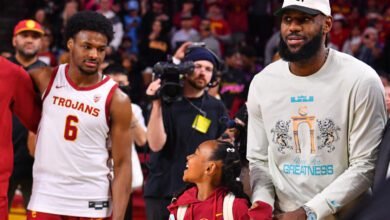ESPNW Summit captured this powerful moment in women’s sports

BROOKLYN, NEW YORK – MAY 09: Sarah Spain speaks during the 2024 espnW New York Summit at the 1 Hotel … [+]
The espnW NYC summit brought together current and future leaders in women’s sports, highlighting a common focus in this historic moment shaping the landscape. Sarah Spain kicked off the summit by presenting key viewership and attendance figures, showcasing the significant momentum and growth experienced by women’s sports during the 2023-24 seasons. While enthusiasm is high, discussions emphasized the importance of sustaining this growth beyond the Caitlin Clark Effect. Looking back, women’s sports have seen increases before, such as during the early years of the WNBA with impressive attendance numbers. However, these highs eventually declined, reaching historic lows in recent years, underlining the need for continued innovation, promotion and investment to secure the future of women’s sports leagues and teams.
“Keeping your foot on the accelerator”
WNBA Golden State President Jess Smith emphasized the need for women’s sports stakeholders to maintain momentum by “keeping our foot on the gas.” Throughout the summit, it became clear that women’s sports leaders are determined to be better prepared this time and intend to leverage phenomena like the Caitlin Clark Effect. Discussions centered around exciting new trends and objectives for sustained growth in the future, highlighting increased global investment in women’s sport and the recognition that sustained growth requires continued investment. Crucially, women’s sport is now recognized as a significant industry and lucrative business opportunity. This recognition is a vital step towards consolidating the legitimacy and value of women athletes, teams and leagues, positioning them not only as strong individual brands, but also as reliable investment opportunities.
BROOKLYN, NEW YORK – MAY 9: Sarah Spain, Jerritt Elliott, Erin Matson, Brian Pensky and Tomekia … [+]
Name, image and likeness (NIL)
A significant aspect of this changing landscape is the recent changes to the name, image and likeness (NIL) policy in amateur athletics. Coaches, who previously opposed the idea of their student-athletes earning money while competing in college sports, are now embracing this evolving reality, including national championship coaches and summit opening panel member Brian Pensky from FSU (women’s soccer) and Erin Matson from UNC (Field Hockey). This opening panel reflected a general recognition that these changes to the NIL present substantial opportunity and greater equity for female student-athletes. Unlike their male counterparts, female student-athletes often have fewer professional playing opportunities, but changes to the NIL increase their earning potential across all sports during a highly visible period in their playing careers.
BROOKLYN, NEW YORK – MAY 09: ESPN host Andraya Carter, ESPN SportsCenter anchor Elle Duncan, and … [+]
Media and social media
Female athletes continue to excel in social media spheres, capitalizing on their exposure to increase their earning potential and their brands. On average, female athletes receive about 8 times more engagement per post compared to their male counterparts. In addition to the high engagement seen in women’s basketball during the 2023-24 season, college softball athletes get nearly 10 times more engagement on social media than their men’s baseball counterparts, with their average engagement per post typically five times higher.
Importantly, linear television and streaming platforms are beginning to embrace these trends, providing additional opportunities for fans and new consumers to watch and interact with women’s sporting events. In addition, they are incorporating new talents into their reporting and coverage of women’s events. At the espnW summit, Ali Krieger expressed his excitement about joining ESPN to lead women’s soccer coverage, while League One Volleyball announced a partnership with ESPN to broadcast some of its inaugural professional season games starting in January 2025. These collaborations and hiring decisions indicate a promising prospect for growth and investment in sports beyond women’s basketball.
BROOKLYN, NEW YORK – MAY 9: Host Julie Foudy, Lynn Olszowy, Hannah Hidalgo and Tessa Johnson speak … [+]
Everyone watches women’s sport
The predominant sentiment that echoed throughout the summit discussions was the recognition that women’s sports have a broad audience and that there is no longer a need for female athletes, fans and stakeholders to continually prove this fact. Lindsay Kagawa Colas, keynote speaker and executive vice president of talent at Wasserman, highlighted the ongoing struggle of female athletes and those in women’s sports to demonstrate the industry’s success, contrasting it with the long-standing acceptance and investment in men’s sports .
BROOKLYN, NEW YORK – MAY 09: Host Elle Duncan and Lindsay Kagawa Colas, Executive Vice President, Talent + The … [+]
Women athletes are increasingly tired of the perpetual need to justify and defend their value, and accumulated data is gradually diminishing the need for this additional effort. Throughout the summit, the message remained consistent regarding the emergence of new fans and consumers: there is room for everyone. As Colas emphasized, the movement is expansive and continues to expand at an exciting pace, and it is important to welcome all new individuals, organizations and investors interested in becoming lifelong supporters. Without a doubt, the tide in women’s sports is changing, and the espnW summit highlighted this historic moment of growth.




